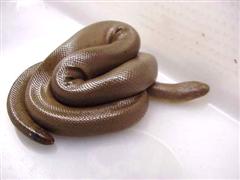Boa - Rubber
Scientific Name: Charina bottae
Thu, 10th July, 2025 - 12:58 am GMT
Sponsor Ads:

Alternative Name
Scientific Name: Charina bottaeBasic Info
A moderately sized snake, the Rubber Boa averages about 24 inches in length with a wide girth. They are called the Rubber Boa' because the smoothness and looseness of their skin makes them feel rubbery when handled. They are plainly colored, usually with a brown or olive dorsal surface and yellow underside.
Health
Breeding Like most other Boas, the Rubber Boa gives birth to live young rather than laying eggs. The Rubber Boa gives birth to between two and eight babies about three or four months after mating, which usually occurs between April and May.Habitat
They are comfortable in a variety of habitats, from dense forests to barren desert scrublandBehavior
The Rubber Boa is a moderately sized snake found throughout North America. While not aquatic snakes, the Rubber Boa is a good swimmer and is rarely found far from water. . They are solitary and secretive in nature, generally hiding in logs or under rocks or bark. They will also burrow into soil and vegetation. Although the Rubber Boa is not arboreal, the can and do climb from time to time. Most of the time, the Rubber Boa is active at dusk and dawn. In times of extreme heat or cold, they will be exclusively nocturnal or diurnal, respectively. When threatened, the Rubber Boa will roll up into a ball with its head at the center and exude a foul smelling musk to ward off predators, though they are not aggressive snakes by nature. While performing this defense mechanism they also raise their tail, which resembles another head.Origin
North AmericaHistory
The Rubber Boa has the widest range of almost any Nother American snake. They can be found from British Columbia south to California and as far east as Idaho. It is, however, most common in the Pacific Coast states such as California. They travel further north than any other Boa, and can survive in temperatures that would quickly kill other snakes. They are difficult to find because they are so secretive, and therefore have very few natural predators. They may sometimes be eaten by hawks and other birds of prey or by raccoons, skunk and other mammals.Common Foods
In the wild, the feed primarily on small mammals, such as shrews and mice. They are not fussy and will eat snakes, lizards and birds as well.Sponsor Ads:
The skill of writing is to create a context in which other people can think. -- Edwin Schlossbergk
Boa - Rubber
Coded by: BGID® | ALL RIGHTS RESERVED Copyright © 2000-2025
Disclaimer | Privacy | Report Errors / Contact | Credits
















